Toyota Corolla (E210) 2019-2025 Owners Manual / Vehicle specifications / Specifications / Tire information
Toyota Corolla (E210): Tire information
Typical tire symbols
Full-size tire
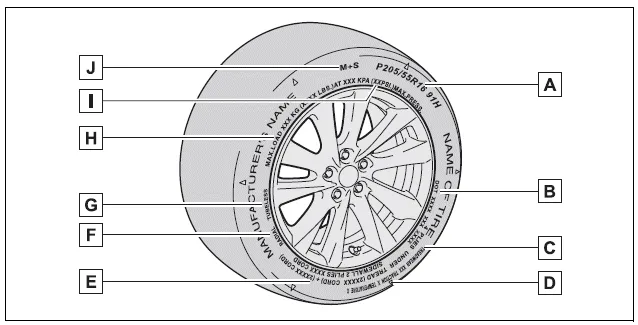
- Tire size
- DOT and Tire Identification Number (TIN)
- Uniform tire quality grading For details, see "Uniform Tire Quality Grading" that follows.
- Location of treadwear indicators
- Tire ply composition and materials Plies are layers of rubber-coated parallel cords. Cords are the strands which form the plies in a tire.
- Radial tires or bias-ply tires A radial tire has "RADIAL" on the sidewall. A tire not marked "RADIAL" is a bias-ply tire.
- TUBELESS or TUBE TYPE A tubeless tire does not have a tube and air is directly put into the tire. A tube type tire has a tube inside the tire and the tube maintains the air pressure.
- Load limit at maximum cold tire inflation pressure
- Maximum cold tire inflation pressure This means the pressure to which a tire may be inflated.
- Summer tires or all season tires
An all season tire has "M+S" on the sidewall. A tire not marked "M+S" is a summer tire.
Compact spare tire
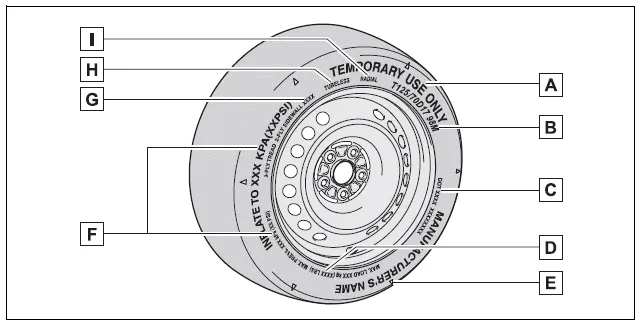
- "TEMPORARY USE ONLY" A compact spare tire is identified by the phrase "TEMPORARY USE ONLY" molded on its sidewall. This tire is designed for temporary emergency use only.
- Tire size
- DOT and Tire Identification Number (TIN)
- Load limit at maximum cold tire inflation pressure
- Location of treadwear indicators
- Maximum cold tire inflation pressure This means the pressure to which a tire may be inflated.
- Tire ply composition and materials Plies are layers of rubber-coated parallel cords. Cords are the strands which form the plies in a tire.
- TUBELESS or TUBE TYPE A tubeless tire does not have a tube and air is directly put into the tire. A tube type tire has a tube inside the tire and the tube maintains the air pressure.
- Radial tires or bias-ply tires A radial tire has "RADIAL" on the sidewall. A tire not marked "RADIAL" is a bias-ply tire.
Typical DOT and Tire Identification Number (TIN)
Type A
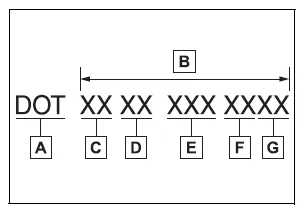
- DOT symbol*
- Tire Identification Number (TIN)
- Tire manufacturer's identification mark
- Tire size code
- Manufacturer's optional tire type code (3 or 4 letters)
- Manufacturing week
- Manufacturing year
*: The DOT symbol certifies that the tire conforms to applicable Federal Motor Vehicle Safety Standards.
Type B
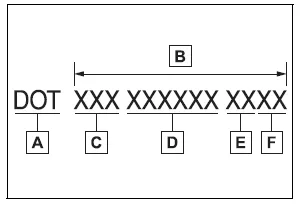
- DOT symbol*
- Tire Identification Number (TIN)
- Tire manufacturer's identification mark
- Manufacturer's code
- Manufacturing week
- Manufacturing year
*: The DOT symbol certifies that the tire conforms to applicable Federal Motor Vehicle Safety Standards.
Tire size
■ Typical tire size information
The illustration indicates typical tire size.
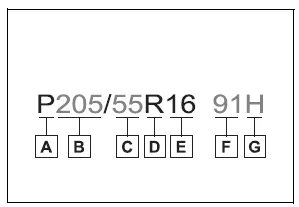
- Tire use (P = Passenger car, T = Temporary use)
- Section width (millimeters)
- Aspect ratio (tire height to section width)
- Tire construction code (R = Radial, D = Diagonal)
- Wheel diameter (inches)
- Load index (2 digits or 3 digits)
- Speed symbol (alphabet with one letter)
■ Tire dimensions
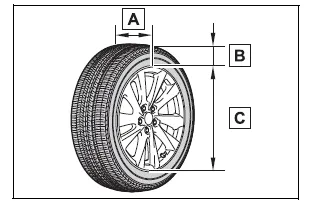
- Section width
- Tire height
- Wheel diameter
Tire section names
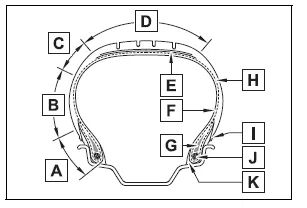
- Bead
- Sidewall
- Shoulder
- Tread
- Belt
- Inner liner
- Reinforcing rubber
- Carcass
- Rim lines
- Bead wires
- Chafer
Other materials:
AHB (Automatic High Beam)
The Automatic High Beam
uses a front camera located
on the upper portion of the
windshield to detect the
brightness of the lights of
vehicles ahead, streetlights,
etc., and automatically
changes the head
lights between the high
beams and low beams.
WARNING
■For safe use
Do not overly rely on the A ...
Replacement
1. Drain brake fluid
Notice:
wash the brake fluid off immediately if it comes into contact with any painted
surface.
2. Remove air cleaner cap sub–assy
3. Remove air cleaner case sub–assy
remove the air cleaner element, then remove the 3 bolts and air
cleaner case sub–assy.
...
Circuit description
The fuel trim is related to the feedback compensation value, not to the basic
injection time. The fuel trim includes
the short–term fuel trim and the long–term fuel trim.
The short–term fuel trim is the short–term fuel compensation used to maintain
the air–fuel ratio at stoichiomet ...


